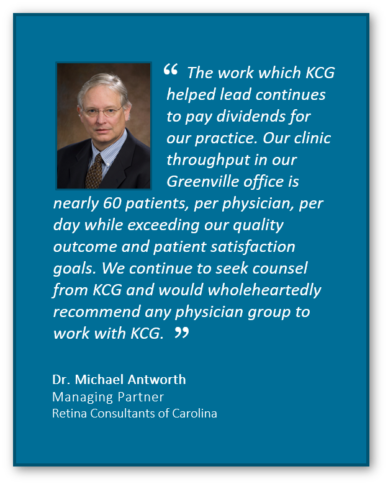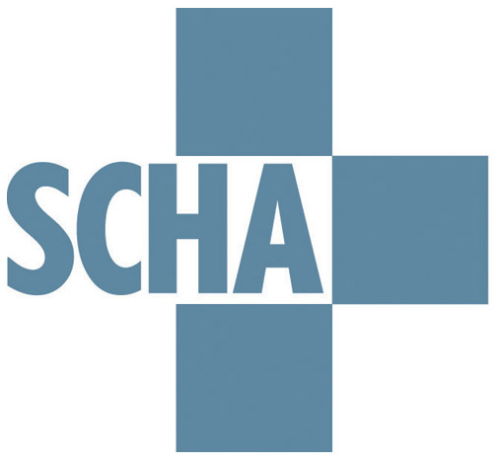Overview
Retina Consultants of Carolina [RCC] is a seven physician, five location Retina-Ophthalmology practice located in the North-Western quadrant of South Carolina. Over the past decade, RCC has experienced significant growth and optimal quality outcomes through the steady dyad leadership of a managing physician partner and practice administrator. However, with continuous growth comes inherent challenges, and when the practice administrator announced their retirement, the physicians felt it was time to address some of these ‘growing pains’.
RCC subsequently engaged Knowledge Capital Group [KCG] to conduct a full operational assessment and provide both observations and recommendations to address areas that impacted practice performance. The resulting report included a narrative specific to financial performance, human resources, infrastructure, organizational scalability, patient access & clinic throughput. This case study is part two of a series, specifically addressing the human resources portion of the report, and how effort in this area helped the practice retain essential labor resources during a challenging period of rapid growth.
The Challenge
RCC’s top resource – the one most essential to practice operations – is its staff. The practice employs 40 non-physician staff members, dedicated to clerical work (8), billing and collections (7), clinical support (15) and scribing (10). Each role has a specific set of responsibilities, and there is minimal cross-coverage. This segmentation of duties and work environment [patient care verses billing, administration and clerical work] created silos among employees and an unprompted leadership structure, with one individual overseeing each department.
RCC lacked a structured approach to human resource management: department leaders were not hired into oversight roles, but rather naturally evolved into their positions; staff engagement, evaluation and discipline were not monitored, documented or standardized, and compensation was inconsistent across employees with similar duties, responsibilities and tenure. Combined, these issues contributed to a high turnover rate [36%], that was costly to RCC’s financial performance, operations and culture.
Approach

To mitigate these challenges, KCG partnered with RCC to implement best practice human resource strategies, better positioning the practice to manage a large workforce, spread across multiple locations. KCG began by conducting leadership and staff interviews, market compensation research, and extensive on-site evaluation of staff performance and leadership competencies. Leveraging the findings of this work, KCG translated its observations and analysis into a comprehensive, future-state roadmap, containing detailed recommendations and prioritized initiatives to achieve desired change. This plan focused on three key areas:
Leadership Competencies
At RCC, non-physician leadership was limited to departmental managers who had been promoted from front-line roles. But, as RCC expanded, its workforce grew to a size that required more expert leadership practices. KCG worked with practice executives to develop tailored action plans for each department manager. The goal of these action plans was to empower managers to more competently and confidently lead their staff, arming them with the necessary tools and scalable resources required. Plans included professional development recommendations, opportunities for continued education, and performance improvement plans, where necessary.
Performance Evaluations
Without formal processes in place to train staff or manage performance, staff competencies ranged from poor to expert, and employees expressed frustration in the lack of opportunities for meaningful feedback and professional growth.
To mitigate this, KCG developed department-specific, individual staff scorecards to guide performance expectations and provide baselines for improvement. Using these scorecards, managers evaluated their employees, assigning scores to individual metrics, which were used to compute a composite score and drive one-on-one professional development discussions. The entire process took about two weeks, with final scorecards maintained as part of each employee’s permanent file. The exercise was designed to be repeated quarterly to allow management sufficient opportunities to document job specific competencies, review professional growth, identify deficiencies, address concerns, and gauge staff satisfaction. In the end, staff feedback of the process was generally positive, with employees appreciating the time and attention that went into curating their personalized feedback and performance plans. Most importantly, job specific competencies were recorded and provided a structured approach for future training and professional development.
Market Analysis & Compensation
Observed to be the greatest contributor to staff turnover was the lack of salary parity within and across departments. Additionally, most salaries were below standard market rates, having remained stagnant for 5+ years. To begin to move the practice toward a more dynamic, performance-based and competitive compensation plan, KCG developed a compensation adjustment methodology.
First, a focused market analysis was conducted, to serve as a baseline comparison figure for a gap analysis. Then, the scores derived from the employee performance scorecards and provider feedback were used to sort RCC employees into three tiers – High, Medium and Low. The number of employees in each tier was normally distributed, fitting a traditional bell curve. The majority of employees fell into the Medium tier. Next, two percentages were assigned to each tier: one that was used to calculate the percentage of salary gap, between market and current salary, that would be applied to the current salary and a second percentage that indicated an increase of current salary, based on performance evaluation scores. Finally, a total budget of $90,000 was set for overall distribution and overlaid on the developed model. This allowed the practice to use the data driven philosophy that rewarded the top performers, without breaking the bank.
Finally, to implement the salary changes throughout the practice, one on one meetings were held with each employee. In these meetings, performance evaluation scores, the conducted market analysis and the individual calculated salary adjustment were reviewed. This allowed each employee to ask any questions they had and gave each an opportunity to learn about how their salary was calculated and how it could increase over time in the future.
Impact
This work enabled Retina Consultants of Carolina to:
- Improve leadership skills
- Establish baseline for staff performance expectations and standardized training curriculum
- Increased staff satisfaction and workplace culture
- Reduced employee turnover rate by 50%
- Decreased dependency on agency staff; reducing recruiting and initial employment costs by 30%
- Cadence of annual budgetary planning inclusive of compensation review and market assessment







